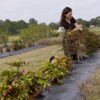Abstract
Based on years of UF/IFAS research producing and trialing cultivars, this 3-page fact sheet lists native and non-invasive, non-native ornamentals as alternatives to invasive plants commonly used in Central Florida landscapes. Only plants considered to be generally available in the nursery trade are listed. Alternative plants are similar to respective invasive plants as much as possible in terms of size, habit, texture, and flower color. This 3-page fact sheet was written by Gary W. Knox, Sandra B. Wilson, Zhanao Deng, and Rosanna Freyre, and published by the UF Department of Environmental Horticulture, August 2013.
References
Fox, A. M., D. R. Gordon, J. A. Dusky, L. Tyson, and R. K.Stocker. 2009. IFAS Assessment of Non-Native Plants in Florida’s Natural Areas: Status Assessment. Gainesville: University of Florida Institute of Food and Agricultural Sciences.
http://plants.ifas.ufl.edu/assessment/pdfs/Final_PDF_SS-AGR-225_04.30.09.pdf.
Fox, A. M., D. R. Gordon, C. Gantz, G. W. Knox, and S. B. Wilson. 2007. IFAS Assessment: Infraspecific Taxon Protocol. Gainesville: University of Florida Institute of Food and Agricultural Sciences. http://plants.ifas.ufl.edu/assessment/infraspecific_taxon_protocol.html. IFAS Invasive Plant Working Group. 2008.
IFAS Assessment of Non-Native Plants in Florida’s Natural Areas. Gainesville: University of Florida Institute of Food and Agricultural Sciences. http://plants.ifas.ufl.edu/assessment/.
Langeland, K. A. 2012. Help Protect Florida’s Natural Areas from Non-Native Invasive Plants. Circular 1204. Gainesville: University of Florida Institute of Food and Agricultural Sciences. http://edis.ifas.ufl.edu/ag108
Unless otherwise specified, articles published in the EDIS journal after January 1, 2024 are licensed under a Creative Commons Attribution-NonCommercial-NoDerivs 4.0 International (CC BY-NC-ND 4.0) license.

